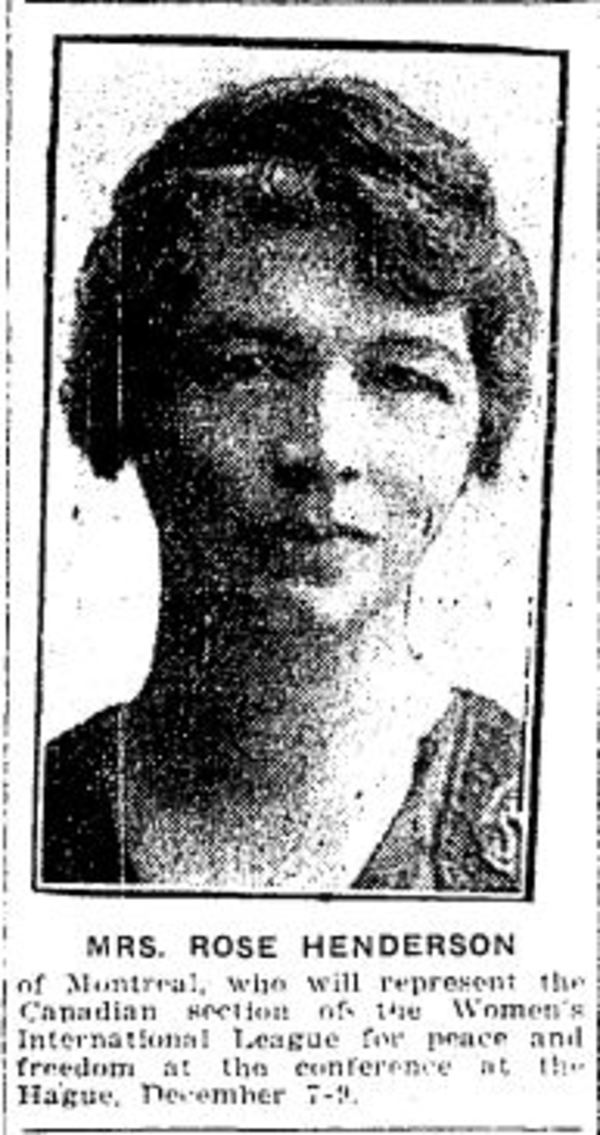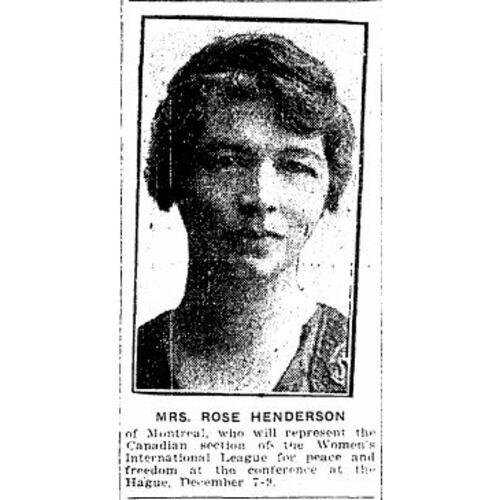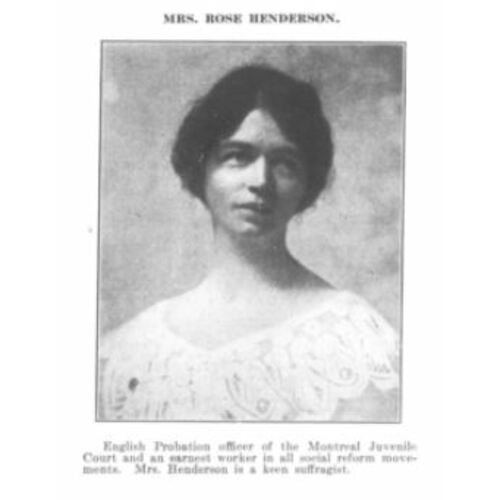
Source: Link
WILLS, ROSE MARY LOUISE (Henderson) (she signed Rose Henderson in her published work), author, youth probation officer, socialist, lecturer, and peace activist; b. probably on 14 Dec. 1871 in Bray (Republic of Ireland); m. Charles A. Montgomery Henderson (d. 15 Jan. 1904), an accountant, and they had a daughter; d. 30 Jan. 1937 in Toronto.
Information on Rose Wills’s background is scattered and inconclusive. Although commonly believed to have been born in Dublin, she was from Bray. Her father, who she claimed had managed a department store in Dublin, is listed in a contemporary source as a church minister. She came to Canada in 1885 under unknown circumstances. The place and date of her marriage remain a mystery. Charles, Rose, and daughter Ida Jane (b. 25 Nov. 1890) all appear at a Montreal address in the 1891 census, yet Henderson told at least one interviewer that she did not move to that city until 1896. In 1918 an article about Henderson in the Canadian Magazine describes Charles as having been financial secretary to Montreal tobacco manufacturer and philanthropist Sir William Christopher Macdonald*, but this assertion has not been confirmed.
Following her husband’s death in 1904, Henderson began to teach in a mission Sunday school in Montreal. Her contact with poor children inspired her to publish Kids what I knows (Montreal, n.d.), stories and poems about young people, often written from their point of view. Her engagement with, and writing on, children emerged from her belief that criminal behaviour in young people was a product of environment, not character. In 1910–11 she undertook work with the Children’s Aid Society, a non-profit youth- and child-protection organization, and during that period she promoted federal legislation restricting the use of cocaine and other drugs. At the request of the federal minister of labour, William Lyon Mackenzie King*, who was drafting a bill on the subject, she travelled to Ottawa early in 1911 to brief him on drug use by young people in Montreal. Her activities led to full-time employment in 1912 as the non–Roman Catholic probation officer of the Montreal Juvenile Delinquents’ Court, established that year and presided over by Judge François-Xavier Choquet*.
By 1911 (or perhaps earlier) Henderson had espoused the Bahá’í faith, which emphasizes the oneness of humanity, God, and religion; she was thus among the earliest Canadian converts. As the non-Catholic probation officer, she frequently worked with Jewish children and lectured numerous times to Jewish organizations in Montreal, influencing the 1914 creation of the Jewish Big Brothers’ Association, which connects male role models to boys in need. In 1915 she was briefly associate editor of Woman’s Century (Toronto), the periodical of the National Council of Women of Canada [see Ishbel Maria Marjoribanks], and would contribute to it regularly until 1919 on issues concerning women and children, labour, and the juvenile court. In October 1916 she began an enduring involvement with left-wing and labour publications by writing for Labor World, the organ of the Central Trades and Labor Council of Montreal; this adherence would estrange her from the Bahá’í community. Two years later she became corresponding secretary for the Montreal branch of the Canadian Labor Party. On 29 May 1919 Henderson testified before the federal royal commission on industrial relations. There, she raised the spectre of impending revolution and placed mothers in its vanguard.
Henderson had briefly supported the One Big Union, formed in western Canada shortly after the Winnipeg General Strike [see Mike Sokolowiski*], and in the early hours of Dominion Day (1 July) 1919 her home and office were raided by police. Among the documents seized were copies of letters she had written to strike leader Robert Boyd Russell* and five prohibited publications, including The communist manifesto. She was pressured to resign her position as probation officer, which she did in December.
Subsequently, Henderson became one of the most famous left-wing political activists in Canada. Over the next two years she travelled the country for speaking engagements in Toronto, Halifax, Vancouver, Winnipeg, and Montreal. Her lectures were well covered by the press and helped her become nationally known. In the summer of 1920 she campaigned for the Independent Labor Party throughout Nova Scotia, where she was called the “premier Labor woman of Canada” by supporters and “a Bolshevik of the worst type” by Halifax society women after they had heard her speak. In the federal general election of 1921 she ran as an unsuccessful Labor candidate in the federal riding of St Lawrence–St George in Montreal, and was the only woman candidate east of Toronto. In 1922–23 she travelled to Ireland and Great Britain, where, in keeping with her views in favour of internationalism, she helped Labour Party candidate Shapurji Saklatvala, an Indian-born member of the Communist Party, campaign for the London seat of North Battersea in the House of Commons. Though she would maintain links with communists throughout her life, she never joined the Communist Party, which was perhaps a reflection of her desire to keep her freedom as an independent thinker.
Henderson admired and defended the Union of Soviet Socialist Republics, and she travelled there in 1924. Following her trip, she became one of the most sought-after speakers in Canada on conditions in the Soviet Union. Her best-known work, the pamphlet Woman and war (Vancouver), which criticizes war, capitalism, and male arrogance, appeared the following year and sold over 10,000 copies. A Labor candidate in New Westminster, B.C., in the federal election of 1925, she polled a greater percentage of the vote than any of the male Labor candidates. In Montreal the next spring she was named secretary of the Society for Cultural Relations between the People of the Dominion of Canada and the Union of Soviet Socialist Republics. At that time she became actively involved with the Women’s Peace Union of the Western Hemisphere, dedicated to non-resistance and universal disarmament.
In 1929 Rose Henderson moved to Toronto, where she lectured regularly on topics ranging from British playwright George Bernard Shaw to the biology and psychology of sex. In October 1930 she was accepted into the Society of Friends (Quakers), a Christian group that emphasizes a personal connection to God and rejects creeds, clergy, and hierarchy. By 1933 she was serving on the executive of the Ontario Labor Party and was vice-president of the Toronto Labor Party. She initially opposed, and then supported, the affiliation of the Ontario Labor Party with the Co-operative Commonwealth Federation (CCF) [see James Shaver Woodsworth*]. She stood as an unsuccessful CCF candidate for Toronto’s Bracondale riding in the provincial general election of 1934, and again for that city’s Parkdale riding during the federal general election the following year. A member of the CCF’s provincial council from early 1936, she worked closely with members of the Communist Party of Canada [see James Bryson McLachlan] in organizations such as the Canadian League against War and Fascism, and earned the respect of social democrats and communists alike. A trustee on the Toronto Board of Education [see Edith Sarah Lelean] from 1934 to her death, she gained citywide recognition for her tireless work on behalf of poor children and her campaigns against corporal punishment and cadet training in the public schools. In 1936 she helped organize the Toronto May Day parade with Communist Party of Canada members, a collaboration for which she was disciplined by the CCF. Throughout her career she was associated with many activist women, including Elizabeth Morton*, Annie Guralnick [Buller*], Laura Lunde [Hughes*], Minnie Singer*, and Harriet Irene Prenter [Dunlop], among others.
Henderson died suddenly on 30 Jan. 1937 while attending a meeting at which she spoke on penal reform. The Toronto City Council acknowledged her passing, flags were flown at half mast by the city’s schools, and Canadians in all walks of life and of all political persuasions eulogized her. The woman who Tom Moore, long-time president of the Trades and Labor Congress of Canada, once claimed had “done more than any other woman for the women and children of Canada” was an indefatigable organizer, inspiring speaker, and trenchant writer. She shared the lives and travails of the poorest of the poor. Her idealism and deep humanitarianism are reflected in the fact that she dedicated her life to the creation of a world without war and poverty, in which all women, children, and workers could realize their full human potential. The Toronto Daily Star stated on her passing: “The world does not produce many Rose Hendersons.”
In addition to the works mentioned in the text, Rose Mary Louise Wills wrote an article under the name Rose Henderson: “Mr. Workingman, listen!,” Industrial Banner (London, Ont.), 5 March 1920.
AO, F 997 (Soc. of Friends (Quakers) fonds). BANQ-Q, E17, 5007/19. LAC, Census returns for the 1911 Canadian census, Que., dist. Montreal (180), subdist. St Antoine Ward (20): 16; “Diaries of William Lyon Mackenzie King,” 12, 13, 17, 18 Jan. 1911: www.bac-lac.gc.ca/eng/discover/politics-government/prime-ministers/william-lyon-mackenzie-king/Pages/diaries-william-lyon-mackenzie-king.aspx (consulted 22 March 2016); R233-36-4, Que., dist. Montreal (172), subdist. St Laurent Ward (F): 54–55; R233-37-6, Que., dist. Montreal (177), subdist. St Laurent Ward (A): 7; R3239-0-9. Swarthmore College (Pa), Peace Coll., DG 043, B, 10 (Women’s International League for Peace and Freedom, Minnesota Metro Branch). Univ. of Toronto Libraries, Thomas Fisher Rare Book Library, ms coll. 00035 (Woodsworth Memorial Coll.). British Columbia Federationist (Vancouver), 20 Feb. 1925. Canadian Jewish Times (Montreal), 13 Feb. 1914; 4 June, 30 July 1915. Gazette (Montreal), 3 Jan. 1912. Halifax Citizen, 25 June 1920. Labour Statesman (Vancouver), 19 Sept. 1924, 6 Nov. 1925. Manitoba Free Press, 30 April 1921. Montreal Daily Star, 15 Jan. 1904, 11 Sept. 1912. Toronto Daily Star, 5 Nov. 1929; 1, 2 Feb. 1937. Workers Weekly (Stellarton, N.S.), 2 July 1920. Canadian who’s who, 1936/37. W. C. van den Hoonaard, The origins of the Bahá’í community of Canada, 1898–1948 (Waterloo, Ont., 1996). Linda Kealey, Enlisting women for the cause: women, labour, and the left in Canada, 1890–1920 (Toronto, 1998). M. J. H. Little, No car, no radio, no liquor permit: the moral regulation of single mothers in Ontario, 1920–1997 (Toronto and New York, 1998). John Manley, “Women and the left in the 1930s: the case of the Toronto CCF Women’s Joint Committee,” Atlantis (Wolfville, N.S.), 5 (1980), no.2: 100–17. Tamara Myers, “On probation: the rise and fall of Jewish women’s antidelinquency work in interwar Montreal,” in Negotiating identities in 19th and 20th century Montreal, ed. Bettina Bradbury and Tamara Myers (Vancouver, 2005), 175–201. Joan Sangster, Dreams of equality: women on the Canadian left, 1920–1950 (Toronto, 1989).
Cite This Article
Peter Campbell, “HENDERSON, ROSE,” in Dictionary of Canadian Biography, vol. 16, University of Toronto/Université Laval, 2003–, accessed January 1, 2025, https://www.biographi.ca/en/bio/wills_rose_mary_louise_16E.html.
The citation above shows the format for footnotes and endnotes according to the Chicago manual of style (16th edition). Information to be used in other citation formats:
| Permalink: | https://www.biographi.ca/en/bio/wills_rose_mary_louise_16E.html |
| Author of Article: | Peter Campbell |
| Title of Article: | HENDERSON, ROSE |
| Publication Name: | Dictionary of Canadian Biography, vol. 16 |
| Publisher: | University of Toronto/Université Laval |
| Year of publication: | 2019 |
| Year of revision: | 2019 |
| Access Date: | January 1, 2025 |




